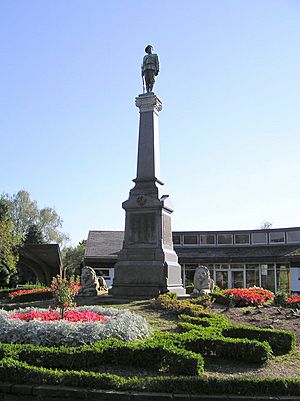Boer War Memorial, Crewe facts for kids
The Boer War Memorial, also known as the South African War Memorial, stands proudly in Queen's Park, Crewe, Cheshire, England. It was built to remember local soldiers who fought or died in the Boer War. The memorial features a bronze statue of a soldier standing on a tall stone column. It was officially revealed in 1903. Plaques on the memorial list the names of those who were lost. This important monument is protected as a Grade II listed building on the National Heritage List for England.
Contents
Why Was the Memorial Built?
Soon after the Boer War ended in May 1902, the people of Crewe decided to build a memorial. They wanted to honor the soldiers from their town who had died in the war. Some say that Crewe sent more men to the war, compared to its size, than any other British town.
A group called the Crewe South African Volunteers' and Reservists' Memorial Fund Committee was formed. This group focused on local volunteers and reservists. They asked the Crewe Borough Council for a good spot in Queen's Park. The council gave them the best location in the park. There was a bandstand there before, but it was taken down.
How Was it Paid For?
The money for the memorial was collected from the public. People donated to help build it. It's believed that the London and North Western Railway Company, even though they had helped Crewe in many other ways, did not donate to this specific project. In total, about £1,050 was raised.
Who Designed and Unveiled It?
The memorial was designed and built by Joseph Whitehead and Sons from Westminster. It was officially revealed on August 8, 1903. Lord Stalbridge, who was the chairman of the railway company, did the honors.
What Does the Memorial Look Like?
The memorial has a bronze statue of a soldier. He is wearing the uniform from that time. The statue stands on a marble column, which is on a stone base. The whole memorial, including the soldier, is about 9 meters (30 feet) tall.
The Soldier's Details
The soldier stands at attention, holding a rifle. He is dressed in what was called "foreign service dress." This uniform includes a slouch hat (a hat with a wide, soft brim), a bandolier belt (a belt with small pockets for ammunition), a pouch, and a water bottle.
The Base and Column
The stone base of the memorial is made from Aberdeen granite. The column itself is made of grey marble with a sandstone top. The base is square. It has a sloped bottom part (a chamfered plinth) with a decorative top (a pediment) on each side. From this base, the marble column rises. The column has a special top called an Ionic cap, which has scroll-like shapes.
Plaques and Inscriptions
On each side of the base, there are bronze plaques. These plaques list the names of the soldiers being remembered. On the north side, you can see the old town's coat of arms. It also has the motto "Never Behind" and the dates 1899–1902, which are the years of the war.
The Locomotive Model
When the memorial was first built, there was a bronze model of a train engine at its base. This engine was named King Edward VII. It was designed by F. W Webb and made by P. H. Lightfoot. The model was 1.2 meters (4 feet) long and weighed more than ten tons. It even stood on tiny rails with 19 sleepers (the wooden beams that support railway tracks). This train model has since been removed. Now, two stone lions stand at the base instead.
Why Is It Important?
The Boer War Memorial was officially recognized as a Grade II listed building on June 14, 1984. Being "Grade II listed" means it is a building or structure of national importance. It has special historical or architectural interest. This listing helps protect the memorial for future generations.


